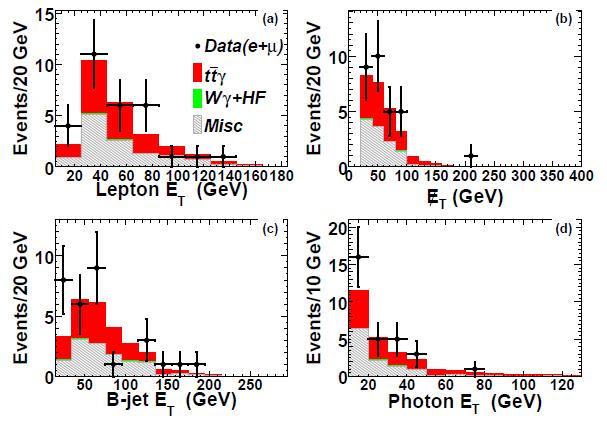There is nothing strange or particular about the fact that any hard production process at a hadron collider can produce, in addition with a massive state such as a top pair, additional energetic photons. That is because any charged particle involved in the process will have a small but finite chance of radiating electromagnetic energy, with a strength governed by our good-old fine-structure constant.
However, the process involving top quarks and a photon may reveal interesting features not yet thought of. In addition, the final state where this signal has been extracted is one which CDF has looked at very carefully in the last 15 years: that is because events with leptons, missing energy, and photons are quite rare in the Standard Model, and the observation of the unexplicable "ee-gamma-gamma-met" event in Run I left everybody speechless back then.
 Ever since the observation of that impossible event, researchers in CDF -in particular a group led by CDF old-timer Prof. Henry Frisch (right)- have pursued the investigation of these final states (see here a short list of works related to photon final states by the group). The paper you can read today is just one among many produced by that line of research. Needless to say, there were never any hints of new physics in the CDF data samples of leptons, photons, missing energy, b-jets, and similar others; but we have learned a lot in the process.
Ever since the observation of that impossible event, researchers in CDF -in particular a group led by CDF old-timer Prof. Henry Frisch (right)- have pursued the investigation of these final states (see here a short list of works related to photon final states by the group). The paper you can read today is just one among many produced by that line of research. Needless to say, there were never any hints of new physics in the CDF data samples of leptons, photons, missing energy, b-jets, and similar others; but we have learned a lot in the process.Below you can see the distribution of a few kinematical quantities which distinguish top production from background processes, for events containing a energetic (Et>10 GeV) photon candidate. From top to bottom and from left to right you find the primary lepton transverse energy, the missing transverse energy, the transverse energy of the leading b-tagged jet, and the photon transverse energy.

Predicted backgrounds excluding ttgamma production amount to 13 events, but 30 events are seen. The predictions for the signal amount to 13.9 events, so the total data is in good agreement with being the sum of signal and backgrounds. What's more, the same top-pair selection with no photon requirement extracts a sample of 4429 events, where the same background estimation technique provides a prediction of 4420+-340: the obscenely good agreement of counts in this super-set confirms that things are in good order.
The statistical significance of the excess above 13 events expected, after all is said and done, amounts to exactly three standard deviations. Unlike mass bump hunts, these three-sigma are a genuine signal, and the claim that this is indeed the first evidence of ttgamma is well founded. So, congratulations to the CDF colleagues for this important new result!



Comments